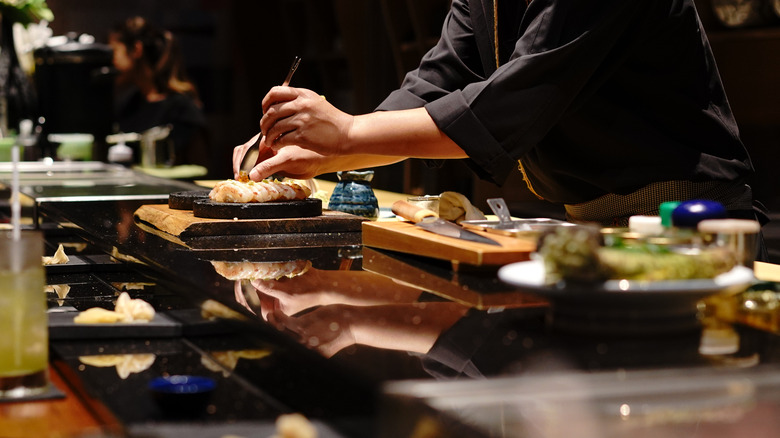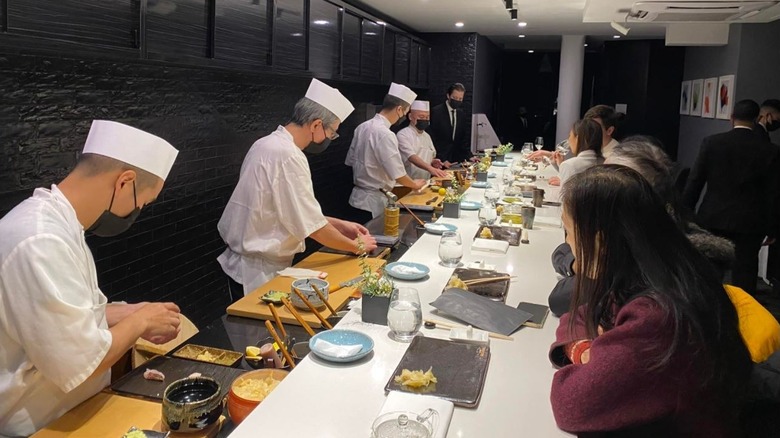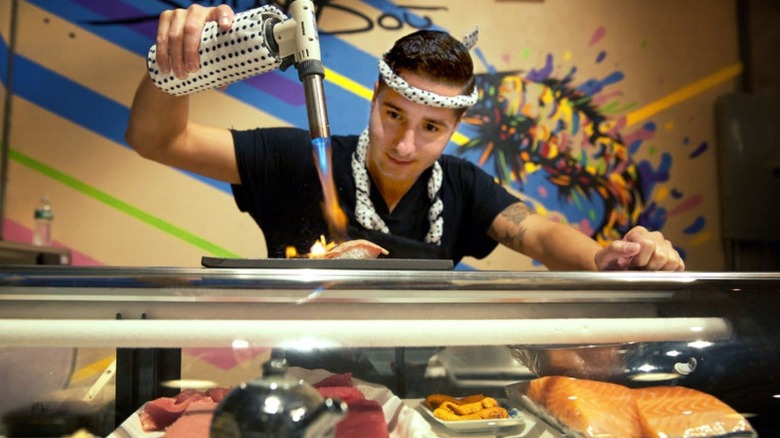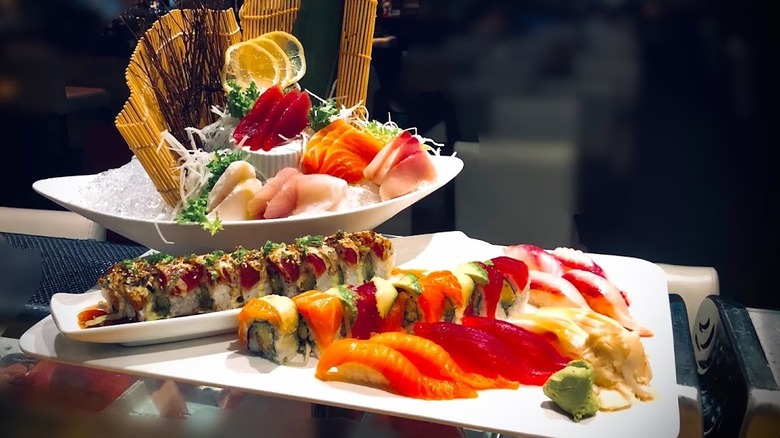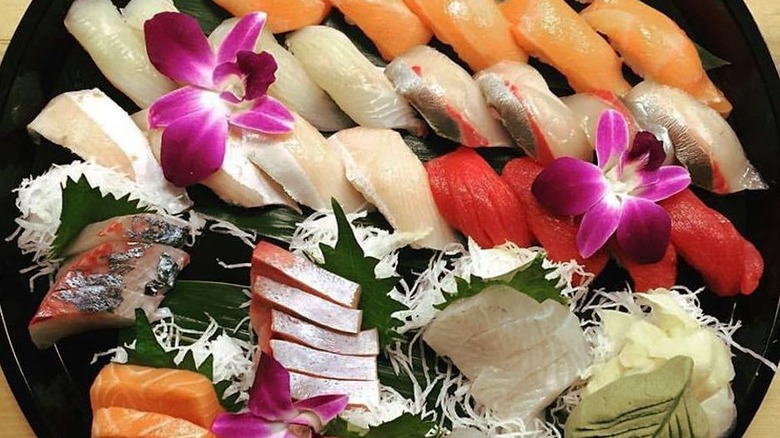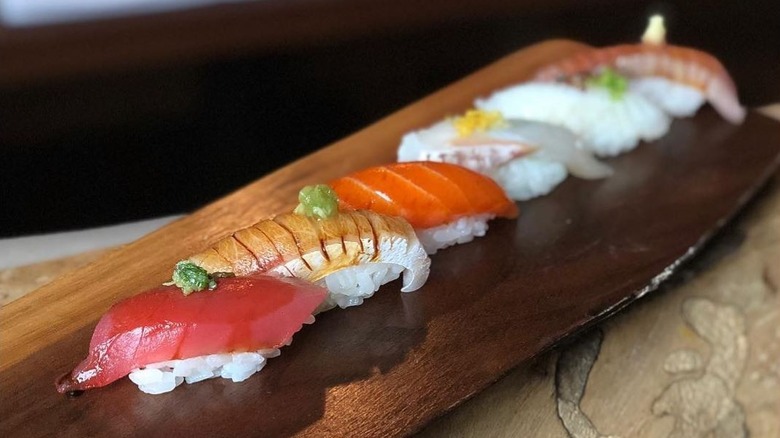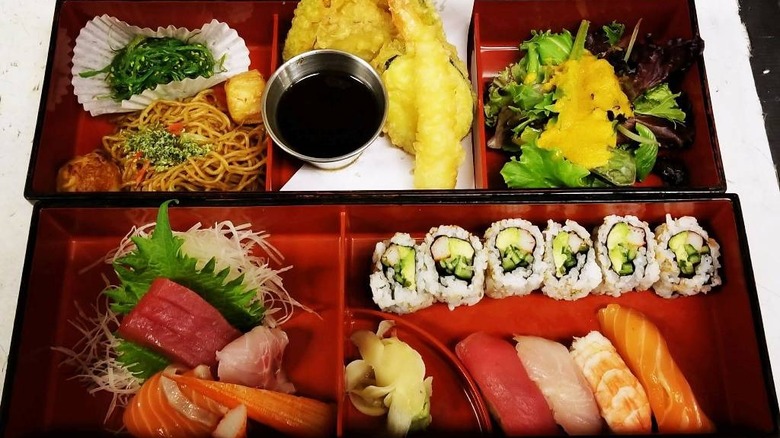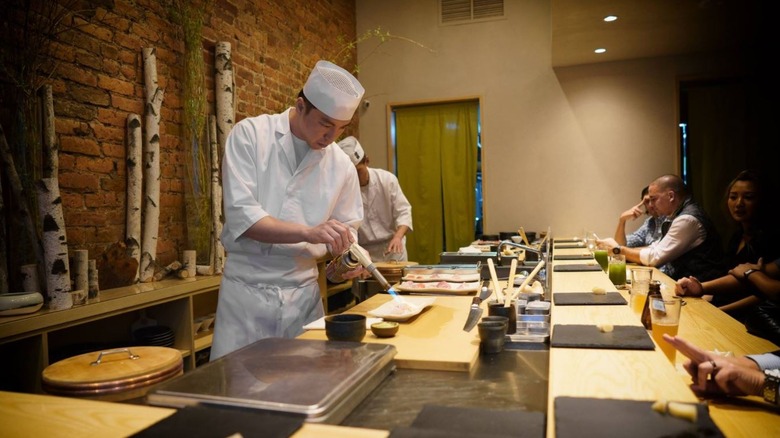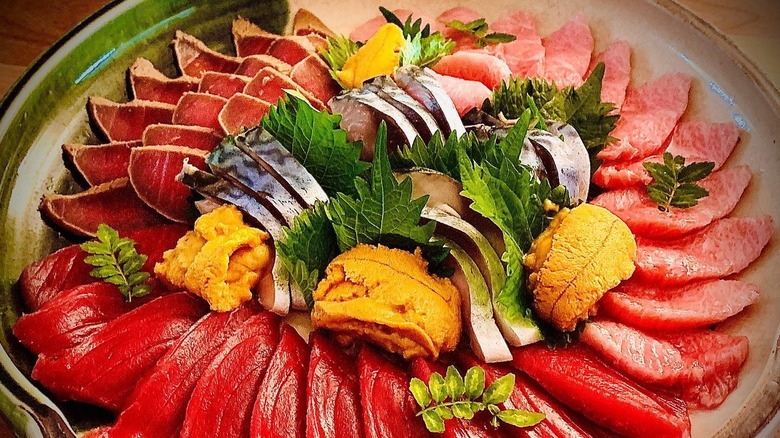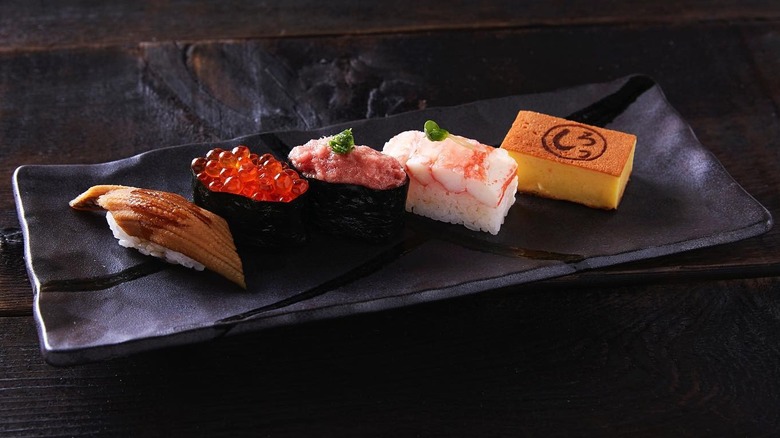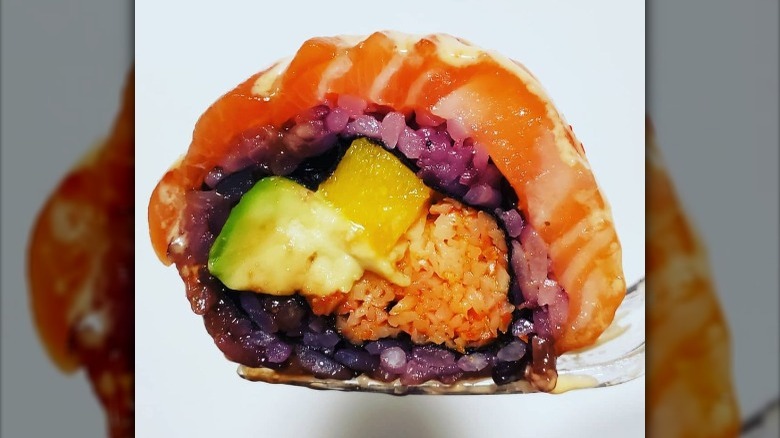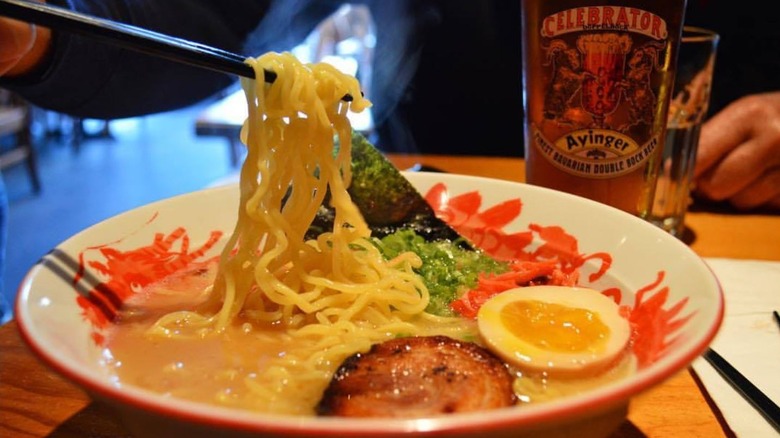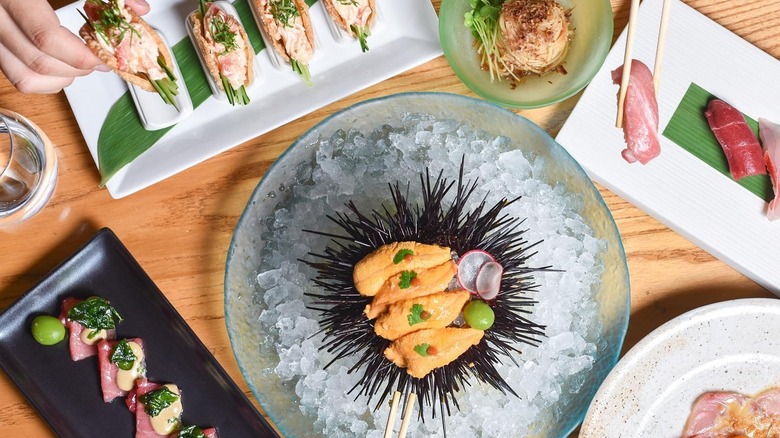The Absolute Best Japanese Restaurants In The US
We may receive a commission on purchases made from links.
When you meet up with a group of friends for dinner and someone suggests going for an elegant dining experience, Japanese food is often among the options discussed. If you've ever been inside a Japanese restaurant, a vibe of peacefulness and subtle decadence wafts through the space. The food isn't just a meal to fill your belly, either. It's as if the chef is an artist and the plate a blank canvas eagerly awaiting to adorn a culinary masterpiece – which is in fact the principle behind moritsuke, or the art of presenting Japanese food. From extravagantly assembled sushi rolls to vibrantly colored ingredients, Japanese food is what you seek out when you want a dining experience worth remembering long after you leave.
Luckily, there's no shortage of Japanese restaurants throughout the United States. Of course, all don't hit a grand slam with every dish they serve, so you have to do your research before embarking on a quest to capture the taste of Japan. However, instead of slaving away behind a computer screen in search of the best Japanese spots in the country, we've done you the courtesy of compiling a must-visit list. So, put in some vacation time at work, change the oil in your car, and prepare for a road trip around the country enjoying the best Japanese restaurants America has to offer.
Sushi Nakazawa - New York City
You really can't consider yourself a true fan of sushi without having seen the eye-popping and drool-inducing documentary "Jiro Dreams of Sushi". In the film, a master sushi chef named Jiro Ono explains his often grueling but impeccable efforts towards serving the greatest sushi in the world at his small 10-seat restaurant in Japan. One of the apprentices working for Jiro in the film is a chef named Daisuke Nakazawa. After years of intense labor under the sometimes-totalitarian rule of Jiro, Nakazawa opened up two of his own Japanese restaurants in America, in New York City and Washington D.C. He brought with him all the skills he mastered in Japan and presented them to customers at his brainchild Sushi Nakazawa.
Now, one thing to definitely keep in mind before making reservations at Sushi Nakazawa is the only menu available is a 20-course omakase tasting ($180 at the sushi counter or $150 in the main dining room). So, if you happen to be in the company of people who are looking to snag a few appetizers and entrées, you'll have to look elsewhere. But rest assured the omakase here is next level, so if you have the budget, convince your entrée-craving friends to go. Pete Wells reviewed the spot in the New York Times, raving that the experience was "original and unexpected. I also knew that no other omakase meal lobbed out so many thrilling pieces of sushi, or was quite as entertaining."
Sushi by Bou - New York City
There's something enticing about visiting a restaurant where you know the chef was embroiled in a bit of controversy at one point. Well, when it comes to Japanese food and New York City, sushi chef Dave Bouhadana from South Florida fits that very description. Per Thrillist, Bouhadana faced a spout with the Department of Health after he fought hard to abolish a law that mandated sushi chefs to wear plastic gloves while handling the fish. His actions resulted in the loss of his job at Sushi Dojo in downtown Manhattan, but little did everyone know, the "glove bandit" was about to come back with a vengeance.
Not long after the setback, Bouhadana opened Sushi by Bou, and it quickly gained popularity for its unique and affordable omakase concept. Customers reserve either a 30-minute or 60-minute window of time to eat, and the 12-piece omakase is perfectly paced so that each bite fills the timeslot to the end. You arrive, sit down, and the show immediately begins. And boy, what a delicious show it is, especially when you reach the Wagyuni piece (Wagyu beef topped with uni). If you're a fan of the concept, you can even reserve a spot in a hotel suite in New York's Hotel 32|32 for a small and intimate 17-course menu. Chef Bouhadana truly took an unfortunate situation in his career and turned it around into something spectacular.
Masa - New York City
According to Masa's website, Travel + Leisure Magazine loved the restaurant's dining experience, describing that "You'll be transported to an ethereal realm where chef Masa creates one of the premier dining experiences in the world." Those are some pretty spectacular words. But, if you look at what's happening at Masa thanks to sushi master Masayoshi Takayama who runs the show, it's not surprising it received such high praise. When it comes to over-the-top decadence in restaurants, which Masa has in droves (it holds three Michelin stars), you better be ready to shell out a whole lot of money. As in the kind of money that could pay a month's rent. Masa is one of those destinations you spend a long time saving for, to splurge on some of the finest Japanese food to ever touch a taste bud.
Located in New York City's Time Warner Center in Columbus Circle, Masa offers an omakase menu for those ready to spend, spend, and spend some more. At a whopping $450 per person, the prices are enough to startle anyone, but once that feeling of wallet-draining dread leaves, the food that hits your plate is beyond magical. Chef Masa says, "I try to bring 100 percent of the essence of something, the umami to the outside –- that is what I'm trying to do." Luckily, he also offers a cheaper Masa location called Kappo Masa that offers diners options other than omakase.
Arami - Chicago
When you ask people what food they associate with Chicago, most people will loudly declare "deep dish pizza!" and they'd have a good point for saying so. Chicago is famous for its lasagna-like pizza pies, but foodies who visit should do their very best to look beyond the pizza and focus on Japanese food. Case in point: Arami. Arami doesn't just sling amazing sushi, and the menu is full of amazing food that makes the journey to the Windy City well worth your time. Writer Phil Vettel of the Chicago Tribune writes, "Arami is one of the best-balanced Japanese restaurants in Chicago, a multi-tooled player where the sushi bar and hot kitchen both operate at high levels, helped along by a surprisingly thorough beverage program."
Arami's list of nigiri isn't enormous, but the quality of the fish is what makes it special. Choices like yellowtail, scallop, eel, and fatty tuna play a large role in the à la carte game. But, before you go swinging in the ring with the sushi, the appetizers beckon you as well. Check out the zuke maguro kani for a spicy Alaskan king crab wrapped with marinated tuna and topped with crispy shallots. Or, try their take on tostadas with the akami sake tostadas: bluefin tuna and salmon sashimi, chili oil, guacamole, spicy roasted almond, microgreens, and lemon zest all balanced on one delicious toasted tortilla.
Uchi - Austin
Very often when you encounter a sushi master, they are of Japanese descent. That, however, is not the case at all at Uchi, a nifty Japanese spot located inside a refurbished bungalow in Austin, Texas. The chef, a James Beard-winning American sushi master named Tyson Cole who trained for 10 years under two different sushi masters, opened Uchi in 2003. "The cuisine I create is playfully multi-cultural, mixing the Japanese tradition with tastes that inspire me," chef Cole says. One look at the menu lets you know this guy means business when it comes to creating stellar Japanese dishes.
For those who may not want to take a straight-up sushi plunge with just nigiri or sashimi, you'll find a plethora of amazing menu options to choose from. The array of cool and hot tastings is too unique not to try, so show up to Uchi with an open mind regarding flavor combinations. The hirame usuzukuri consists of thinly sliced flounder, olive oil, and candied quinoa. The maguro goat comes with bigeye tuna, pumpkin seeds, and goat cheese. The combinations are wild yet so enticing, and there's even a list of tempura options like kabocha (Japanese pumpkin), karaage (chicken thighs with sweet chili and seasonal pickles), and hana (cauliflower).
TOMO - Atlanta
A superb eye for quality is imperative when running an eatery, but at Japanese restaurants where raw fish is typically served, an eagle eye for quality is that much more crucial to avoid any potential health risks. That's why having a chef like Tomohiro Naito at the helm of a restaurant is so important. Born in Osaka, Naito moved to Queens initially to study theater direction. However, after landing a job at a Japanese trading company sourcing seafood, he realized his passion was nestled within the culinary landscape, so he took a hard turn into the cutthroat world of food. The absolute obsession he developed for food helped him make his way through the ranks of the prestigious Nobu restaurant in Las Vegas, and he eventually migrated to Atlanta, Georgia and opened TOMO.
The TOMO menu has options for everyone, and if you're seeking a meal filled with sashimi, you're at the right place. But, if you want to explore other decadent options (and there are a whole bunch), TOMO hits a home run with its large menu. For starters, snag some flash-fried tulipped chicken wings served with a garlic-ponzu sauce or the black cod Boston, a hefty serving of broiled sweet miso-marinated cod with hydroponic Boston lettuce and garlic chips. Then, move on to a delicious entrée of Scottish salmon with wild mushroom teriyaki demi-glace. Whatever you end up eating, just know you win.
Sushi Zo - Los Angeles
It can happen that from an early age, someone knows exactly what they want to do with their life. Even though they've had almost no life experience yet, an innate passion is present from the very beginning. That's exactly how chef Keizo Seki felt about sushi. Born in Osaka, he knew his lifelong goal was to carve his name into the wall of sushi masters, so he ventured to Tokyo to hone the skills. In 2006, chef Seki finally opened up his first restaurant, Sushi Zo, in West Los Angeles, earning a coveted Michelin star within three years. Chef Seki is on a path to greatness, and anyone who dines at one of his several Sushi Zo locations is well aware once they taste his food.
Sushi Zo offers omakase only, but the care put into each piece is stunningly evident, and the restaurant's website does a phenomenal job explaining their method of ensuring every morsel of oceanic decadence is perfect. According to the site, the most important aspects of sushi are the seafood topping (neta) and sushi rice (shari). A sushi master's goal is to achieve absolute ittai-kan, which is a perfect harmony between the two. Sushi Zo's rice is seasoned with a blend of vinegars, draped with the highest quality seasonal fish, and served at body temperature so as not to startle the palate. Come for omakase, leave with a new passion for Japanese cuisine.
Kusakabe - San Francisco
Finding sushi in San Francisco isn't that difficult. But, finding a place that serves only omakase is. That's where Kusakabe comes into play as San Francisco's very first all-omakase restaurant. The chef who runs the show, Mitsunori Kusakabe, not only earned a Michelin star for his fine work but was also the winner at the World Sushi Cup and the U.S. Sushi Technical Competition. This guy knows his way around a piece of nigiri. As San Francisco Chronicle food critic Matt Bauer said about his experience, "Finally I discovered what a true omakase menu might mean." With its multi-course kaiseki-style concept reflecting seasonality and harmony –- five colors, five tastes, five senses, and five methods –- Kusakabe wows everyone who walks through the doors, creating a memorable evening.
The omakase experience costs $185 per head, so it's definitely not the kind of place where you would just stop in for a bite to eat. You may have to prepare your finances for the night out, but it's worth every penny when you see the care and craft that the chefs exhibit at each step of the meal. Interestingly enough, even though the restaurant claims it only serves omakase, there is an à la carte menu, however, customers can only order it after the omakase ends. The menu has four choices, and they're meant to be taken home and enjoyed. Inside the restaurant, it's one-piece-at-a-time sushi dining only.
Shiro's Sushi - Seattle
Shiro's Sushi proudly stands by the fact that, according to them, they're Seattle's very first Edomae-style restaurant. What does that mean exactly? Well, traditionally it refers to fish caught in the waters of Tokyo Bay. However, nowadays it refers to a specific style of preparing fish that was popular in Tokyo many years ago. The process uses wooden cutting boards, bamboo leaves, and pickled root vegetables to help ensure the freshness and sterilization of the different cuts of fish. Although Shiro Kashiba who opened the restaurant in 1994 has since moved on to new ventures, the restaurant still has a menu full of awesome items.
If it's à la carte sushi you're after, you have a whole list of great choices to pick from. Fish like gizzard shad, sea bream, sockeye salmon, and sea perch all hold a spot, as well as monkfish, two varieties of eel, and two kinds of sea urchin. But, if you want to dabble in something truly unique then look to the sushi burgers. That's right, Shiro's has a selection of four burgers -– salmon and smelt, chicken, shrimp, and vegan –- complete with a variety of fixings, all nestled between two tempura rice buns.
Harumi - Phoenix
Most restaurants have a certain element that sets them apart from other spots serving similar cuisine. A trademark dish or ingredient gets people talking, garners interest in potential new customers, and usually ends up on some kind of social media outlet in the form of ornately assembled photos. Well, Harumi in Phoenix, Arizona, certainly has a unique item that makes people do a double take: purple rice. Yep, at Harumi, they serve their sushi using rice that's a vibrant purple color. Also known as "forbidden rice," the purple starch has more antioxidants and fiber and much less sugar and carbohydrates. But, don't just visit for the oddly colored rice; Harumi's whole menu is off-the-charts awesome.
Before basking in the vast amount of sushi Harumi offers on its menu, snag one of their amazing appetizers to kick off the meal properly. Order the Ahi Tower for an epic culinary obelisk consisting of sushi rice (purple, of course), spicy tuna, crab salad, avocado, tobiko, eel sauce, spicy mayo, and tempura flakes. Or, if you're feeling spicy, get the deep-fried stuffed jalapeño with spicy tuna, crab salad, cream cheese, and a drizzle of eel sauce and spicy mayo. The selection of special rolls is amazing, like the Hot Havana with spicy yellowtail, jalapeño slices, and mango-habanero sauce, or the Oasis with tuna, Scottish salmon, crab salad, avocado, spicy ponzu sauce, spicy mayo, and eel sauce all wrapped in thinly sliced cucumber for a crispy texture.
Pai Men Miyake - Portland, Maine
Opening a restaurant is certainly a journey, which means having an adventurous spirit is vital for any chef who dreams of one day running their own successful operation. Venturing into the precarious world of restaurants can oftentimes lead to frustration and disappointment, and even though Masa Miyake was well aware of the risk, he harnessed his enterprising spirit and opened Pai Men Miyake in 2009. Chef Masa is so dedicated to fully absorbing his employees in the culture of Japan that in 2014 he began arranging staff trips to the country so everyone could gain an appreciation for the country's history, cuisine, and hospitality. And, thanks to those trips, the team always returns ready to give customers at Pai Men Miyake the greatest experience possible.
Obviously, much of that experience has to do with the food, and Pai Men Miyake does not disappoint. On the menu, you'll find a selection of great appetizers and specialty sushi rolls, but they seriously throw down their ramen game. Order the duck ramen for a uniquely rich bowl of duck and chicken broth with duck breast, savory duck meatballs, and a variety of veggies. Or, get your surf on with the lobster ramen: an umami-packed bowl of lobster miso broth, a full lobster tail, bok choy, and a soy egg. Whatever you choose from the menu is going to yank your satisfaction lever hard, so keep it well-oiled.
Nobu - Nationwide
It's impossible to rattle off a list of phenomenal Japanese restaurants and leave Nobu out of the lineup. To quote the sushi master behind the massive multi-location operation, Nobu Matsuhisa, "I always put something special in my food, my heart." Well, his heart must be exponentially larger than most, seeing as he didn't just establish an amazing restaurant, but a slew of hotels, as well. Chef Nobu doesn't monkey around when it comes to enormous success, and he's got the track record to prove it. For those fascinated by how the chef built a worldwide culinary empire, they can order his book, Nobu Matsuhisa: A Memoir. For others who just want to treat their appetites like royalty, they can visit one of the many locations throughout the world.
A restaurant doesn't just take over the culinary world without serving absolutely impeccable food, and that's why Nobu reigns supreme (but keep in mind you're about to spend an arm, leg, and part of your torso on the meal). On the menu, you'll find cold and hot starter dishes, like toro tartare with caviar, lobster shiitake salad with spicy lemon dressing, umami sea bass, black cod with miso, and ribeye with yuzu honey truffle (drooling yet?). Nobu also has a selection of Japanese tacos filled with your choice of seafood or Wagyu steak. Chef Nobu Matsuhisa's name will live on for quite some time, and he's more than deserving of it.
